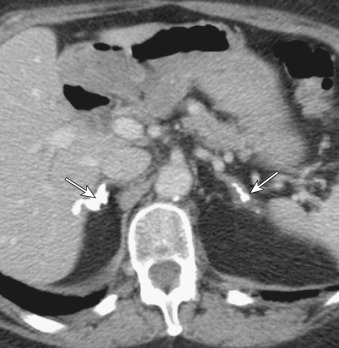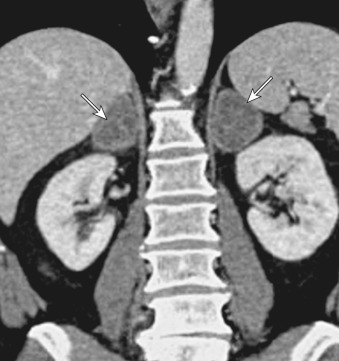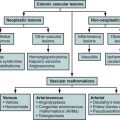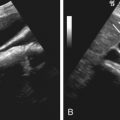Recent technical advances in computed tomography (CT) and magnetic resonance imaging (MRI) have resulted in improved detection of subtle changes in adrenal gland morphology. The different morphologic patterns of adrenal gland enlargement on imaging can be classified as follows ( Figure 70-1 ):
- •
Diffuse enlargement
- •
Focal nodule or mass in a limb
- •
Multiple nodules in the gland
- •
Nodule with a smaller nodule within the nodule, the so-called nodule within a nodule appearance

The various causes and imaging manifestations of diffuse enlargement, multiple nodules in a single gland, and nodule within a nodule are discussed here.
Diffuse Enlargement
The adrenal gland is diffusely enlarged and usually maintains the normal adrenal shape. The limbs of the adrenal glands are longer than 5 cm and exceed 10 mm in thickness. The causes of diffuse enlargement include adrenal hyperplasia, lymphoma, metastatic disease, tuberculosis, and histoplasmosis.
Adrenal Hyperplasia
Adrenal cortical hyperplasia may be primary or secondary to a pituitary or hypothalamic lesion or ectopic production of adrenocorticotropic hormone (ACTH). Clinically, adrenal hyperplasia often manifests as Cushing’s disease. It also may be associated with Conn’s syndrome or adrenogenital syndrome.
On CT and MRI, hyperplasia of the adrenals is commonly present as enlarged glands bilaterally but maintains an adreniform shape with a smooth surface ( Figure 70-2 ). Rarely, adrenal hyperplasia may have a normal appearance or nodular enlargement. The maximum diffuse enlargement of the adrenals in hyperplasia is associated with ectopic ACTH production secondary to various tumors, such as bronchial carcinoid. In a patient with hyperaldosteronism, differentiation of adrenal hyperplasia versus hyperfunctioning adenoma is critical because adrenal hyperplasia is treated medically, whereas a hyperfunctioning adenoma requires surgery. Renal venous sampling is usually indicated in patients with hyperaldosteronism, particularly when a focal nodule on cross-sectional imaging is not identified. Most often, hyperaldosteronism is associated with micronodules that are not usually detected on CT or MRI; hence, even if hyperplasia is identified on CT or MRI, renal vein sampling is still performed to exclude unilateral hypersecretion of aldosterone.
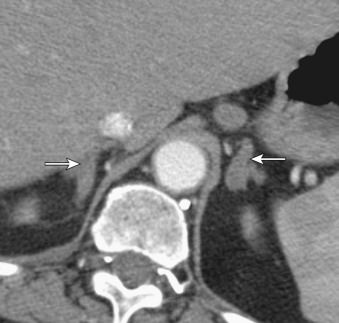
If a focal nodule is not identified on imaging in patients with hyperaldosteronism, further evaluation is usually performed with renal vein sampling.
Lymphoma
Adrenal involvement occurs in nearly 25% of patients with non-Hodgkin’s lymphoma (NHL) at autopsy. Adrenal involvement in NHL is usually associated with diffuse enlargement similar to hyperplasia. However, here the enlargement is either asymmetric or unilateral. On CT, adrenal lymphoma appears as unilateral or bilateral homogeneous solid involvement without calcifications. The shape of the adrenals may be maintained, and mild enhancement may be noted after intravenous administration of a contrast agent. In NHL, the adrenal gland involvement may be due to a primary or metastatic lymphoma. Primary adrenal NHL involves only the adrenal gland and is very rare. It tends to be cystic and heterogeneous, which makes it difficult to differentiate from adrenal cortical carcinoma, pheochromocytomas, and metastasis. It is bilateral in 50% to 68% of cases. The common presentation of adrenal primary NHL is adrenal insufficiency, and it is known to be the most common cause of adrenal insufficiency secondary to malignancy. The diagnosis is suggested by the presence of lymphadenopathy elsewhere; however, lymphadenopathy is not required to make a diagnosis. MRI features of lymphoma are nonspecific and may resemble metastases. Typically, the enlargement is hypointense on a T1-weighted image and has variable or heterogeneous hyperintensity on T2-weighted images. Positron emission tomography with CT (PET/CT) is helpful in identification of adrenal as well as extra-adrenal involvement. The 18F-fluorodeoxyglucose (FDG) uptake will be greater than the liver uptake in adrenals with lymphomatous involvement.
Granulomatous Disease
Granulomatous infections are usually due to tuberculosis or histoplasmosis and are the second most common cause of chronic adrenal insufficiency in the United States, after idiopathic Addison’s disease.
In adrenal tuberculosis on CT, the glands are often asymmetrically enlarged. Acute bilateral involvement results in adrenal insufficiency. In the subacute phase, adrenal enlargement with peripheral enhancement and with cystic low-density or necrotic changes may be present. In the late phase, either diffuse or focal calcifications are present ( Figure 70-3 ). Nearly 50% of adrenal calcifications are secondary to tuberculosis. In diffuse involvement with histoplasmosis, the adrenals are also enlarged, with peripheral enhancement and central low density ( Figure 70-4 ). The adrenal enlargement may be more symmetric than in tuberculous involvement. Calcifications also may be present.
